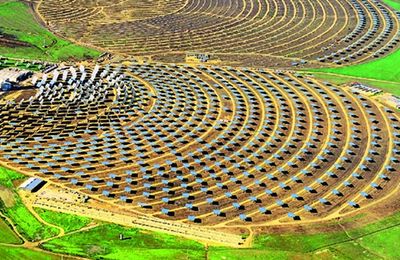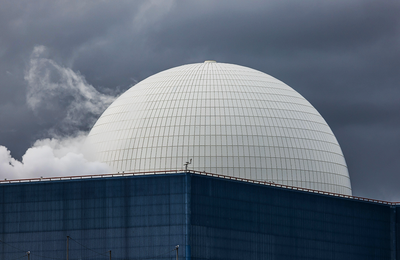In 1978 President Jimmy Carter gave a speech praising a new National Solar Energy Research Institute, and extolling the sun’s “inexhaustible sources of energy. No cartel controls the sun.” He even installed 32 solar panels on the White House roof and founded an annual “Sun Day” celebration. But after Reagan rode into office, the solar panels were removed, Sun Day disappeared from the calendar, and the rest is history. Biden tried again with the Inflation Reduction Act (2022), touted as the greatest climate and clean energy bill in US history; only for Trump to scrap it in his first week in office. A progressive US president enacts bold clean energy policies, only for a right-wing populist to sweep it all aside. There’s nothing new under the sun.
Or is there? In 1978, solar was an expensive novelty; in 2025, it is vying with wind to be the cheapest form of electricity generation there is, and solar adoption figures have surpassed all expectations. In 2009, when installed solar capacity worldwide totalled just 23 gigawatts, the International Energy Agency (IEA) predicted that by 2030 capacity would increase to 244 gigawatts. That mark was reached by 2015, and the world is now installing over 244 gigawatts every six months. “No other electricity source has scaled this quickly”, say the clean energy analysts Ember, driven by “plummeting costs, modular design and fast and easy deployment.”
A large part of this has been driven by China. Its own 2025 solar capacity is double what it was in 2024, and it installed more than twice as much solar capacity in the first half of 2025 than the rest of the world combined. But others are making progress too: Sixteen EU countries now produce more than 10 per cent of their electricity from solar, with Hungary pushing over 25 per cent last year and 40 per cent this summer. In the UK, solar power rose by a third in the first six months of this year. Almost every country’s solar adoption now looks like a hockey stick graph; only this time (unlike Al Gore’s infamous graph) the hockey stick is good news.
China is also powering other countries’ solar transitions. In August this year, China exported 46 gigawatts of panels in a single month—that’s roughly equivalent to 46 large coal or nuclear power plants.
Most exciting is what’s happening in the Global South. In February, energy analysts at the Rocky Mountain Institute reported that renewable energy was growing twice as fast there as compared to the Global North. In Africa, solar adoption rates this year are “off the charts”, says Dave Jones, chief analyst at Ember. Twenty African countries set national records for solar panels imports in the 12 months to June 2025. The solar panels imported into Sierra Leone alone in the last 12 months could meet 61 per cent of its national electricity use.
Jones is seeing much the same trends across the Middle East and Asia, with Pakistan a particular solar success story, enabled by the availability of low-cost Chinese solar panels. China exported 16.6 gigawatts of solar capacity to Pakistan in the financial year ending March 2024, or $2.1bn worth, five times as much as in 2022. The average cost fell by 54 per cent in the same period. Most of the demand came not from solar farms, but rooftops and shopfronts. “Individuals have made this decision” not government, Waqas Moosa, chairman of the Pakistan Solar Association, told NPR. “It's like a democratisation of solar.”
In the US solar is also booming, despite Trump’s best efforts. Solar energy generation is up nearly 40 per cent year-on-year, and are set to account for the majority of new generating capacity installed in 2025. Even Sun Day is back, resurrected by veteran climate author and campaigner Bill McKibben. It took place on 22nd of September, the day after the autumn equinox, with town hall events, community fairs and choreographed dances in solar farms. A tired but jubilant McKibben tells me “it went great—the biggest day of clean energy action in decades, with about 500 events spread out around the country”. His favourite moment was “listening to Antonique Smith, our Sun Day ambassador, sing Here Comes the Sun in the park in Manhattan—and the sun came streaming out from behind the clouds as she did it.”
Here Comes the Sun is also the title of McKibben’s latest book, released to coincide with Sun Day. His front row seat for the past 40 years of the clean energy transition makes him the perfect chronicler (his first book, The End of Nature, was published in 1989).
The modern solar cell was invented in 1954, and it took until 2022 for the first terawatt (a thousand gigawatts) of solar power globally to be installed. It then only took two more years, to 2024, to add the second; the third, he writes, could be in place by this year’s end. One gigawatt of solar panels—again, each equivalent to one large coal or nuclear power plant—is now installed every 18 hours.
Trump arrived back in office too late to stop this expansion. “On election day in November 2024, as the outcome became tragically clear”, writes McKibben, Stanford professor Mark Jacobson shared the contrasting news that “California had managed to produce 100 percent of its electricity from renewables, even with the sun starting to dip in the November sky.” In just that year, solar was up 26 per cent and electricity from batteries by 97 per cent. By March 2025, fossil fuel was producing less than half of American electricity, for the first time.
Some critics have suggested that the rise in solar has simply offset a rise in energy use generally, rather than eating into fossil fuel use and therefore greenhouse gas emissions. Bloomberg columnist Javier Blas, for example, opines that “the world isn’t performing an ‘energy transition’ but an ‘energy addition’, where renewables top up oil, gas and coal.” But China is also reducing coal—in May 2025 China, the world’s largest emitter, had used 4.7 per cent less coal power in the first quarter of the year than it had in 2024. “Despite a surging economy, Chinese emissions were actually dropping”, writes McKibben. On 24th September, Chinese President Xi Jinping announced his country’s first-ever national emissions targets, aiming to cut by between 7 and 10 per cent by 2035, while rebuking the climate retreat by “some countries”—including, by implication, the United States. Its solar manufacturing miracle has made this possible.
McKibben also points to California, now the world’s fourth largest economy, as evidence that solar and wind are reducing emissions, not just “topping up”— California used 40 per cent less natural gas in early summer 2024 than in the same period in 2023. “If, by 2050, we’d convert the world to running on solar, wind, geothermal, and hydro power, we’d actually be using about 56 percent less total energy”, writes McKibben, adding that “just mining, refining, and transporting fossil fuels requires 11 percent of all the energy humans currently use.”
The economics are already way beyond the ‘top-up’ stage. In India, asserts McKibben, currently accounting for half of all China’s solar exports, it costs less to put up a new solar farm than it does to buy the coal to fire an existing power plant. Or compare it to biofuel, to which 60 per cent of America’s corn crop is dedicated: McKibben calculates that an acre of corn will produce enough ethanol in a year to drive a pickup truck about 25,000 miles. But covering that same acre in solar panels would produce enough electricity to run the electric version of the same truck 750,000 miles.
The great solar boom of 2025 finally heralds the clean energy revolution. Wind and solar came close to surpassing global gas power generation in April, for the first time. It will certainly surpass that in 2026, and has likely already overtaken coal (confirmation is expected in the IEA’s annual World Energy Outlook in October).
McKibben is most effusive when it comes to the potential impact that decentralised solar could have on democracy—echoing Waqas Moosa in Pakistan. Around 80 per cent of humans live in countries that are dependent on fossil fuel imports. “Because fossil fuels themselves are easy to concentrate, they often yield authoritarian outcomes.” It’s no secret that the fossil fuel lobby funded Trump’s return to office to the tune of $445m throughout the 2024 election cycle, for example. “[Breaking] the centralised power of the fossil fuel industry is a key form of resistance,” says McKibben.
By contrast, solar power is diffuse and localised. With IEA projections showing that by 2028 solar will generate more than all the world’s hydro dams, and by 2030 solar will have outstripped gas, even without wind’s help—that, for energy, is truly revolutionary. As McKibben writes, “Everything is going wrong, except this one big thing.”













